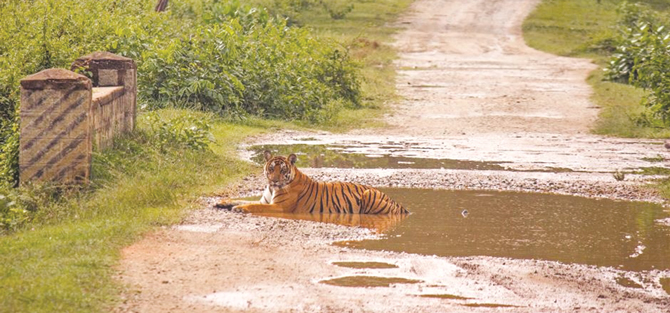Fishing cat heading to extinction in lack of conservation

By Indira Aryal
Kathmandu, May 19: Fishing cat, a medium-sized wild cat mostly found in the wetland areas, is in the verge of extinction with the destruction of wetlands, construction of artificial fishing ponds and declining fish population.
The fishing cat with scientific name Prionailurus viverrinus and locally called Malaha Biralo, is found in Nepal’s Terai lowlands.
Due to rapid population decline of fishing cat over the last three generations since 2008, the species is listed as “Endangered” in the IUCN Red List.
This wild cat lives in the vicinity of wetlands, along rivers, streams and swamps. Habitat loss and destruction of wetlands, and declining population of fishes have led to a fall in the population of these cats, said Rama Mishra, PhD Candidate of Small Cats/Fishing Cat, Department of Biology, Evolutionary Ecology Group, University of Antwerp, Belgium.
Mishra, who also researched fishing cats in the Koshi Tappu Wildlife Reserve and Chitwan National Park in Nepal, said that the country has not made concrete effort to conserve it. It is important to generate community awareness about the ecological importance of this animal, Mishra said.
Its nature to hunt in water sets it significantly apart from other species of cat. It has water-resistant fur and webbed feet to help in swimming and fishing. It is about twice the size of domestic cats with head to body length ranging from 57 to 78cm and 20 to 30cm long tail. In Nepal, fishing cats have been recorded from Sunsari in the east to Kanchanpur in the west. However, the distribution is not regular within its range. These animals have been recorded from five protected areas of the Terai-- Koshi Tappu Wildlife Reserve (KTWR), Parsa National Park, Chitwan National Park (CNP), Bardiya National Park and Shuklaphanta National Park.
They have also been found outside the protected areas in natural wetlands as well as fish ponds of Sunsari, Bara and Kapilvastu districts.
Fishing cat prefers ponds, lakes and marshes but are also found around flowing water.
“These days many people in the Terai have constructed fishing ponds after the fish population declined in natural wetlands. They have raised dogs to look after the ponds. There might be chances of killing those cats by the dogs. This can also be another reason for the declining population of the fishing cats,” Mishra said.
Sanjay Tha Shrestha, a wild photographer and life member of Bird Conservation Nepal, said that he captured photos of a wild cat in Koshi Tappu three years ago, which he claimed the first natural photo. “Earlier, photos of wild fishing cat used to come out from camera trapping,” he said.
According to Mishra, who also founded Terai Fishing Cat Project, Nepal, the species is very skillful at fishing. It taps on the water surface, and when fishes are drawn to the created ripples, it dives into the water to catch them. Its partially webbed feet, rudder-like tail and water-resistant coat assist it in swimming. Aside from fishing, the cat also eats rats, reptiles, small mammals and birds.
It is estimated that approximately 150-200 fishing cats are found in Nepal. They have also been recorded in Pakistan, India, Bangladesh, Thailand, Myanmar, Cambodia, Sri Lanka and Indonesia.
Population of the fishing cat is declining throughout the species’ range. To date, no scientific study has been carried out to determine its status, distribution and conservation status in Nepal.
Himalayan Nature has established the first research in Nepal that aims to determine the population abundance and distribution of the fishing cats in Koshi Tappu Wildlife Reserve (KTWR).
Recent News

Do not make expressions casting dout on election: EC
14 Apr, 2022
CM Bhatta says may New Year 2079 BS inspire positive thinking
14 Apr, 2022
Three new cases, 44 recoveries in 24 hours
14 Apr, 2022
689 climbers of 84 teams so far acquire permits for climbing various peaks this spring season
14 Apr, 2022
How the rising cost of living crisis is impacting Nepal
14 Apr, 2022
US military confirms an interstellar meteor collided with Earth
14 Apr, 2022
Valneva Covid vaccine approved for use in UK
14 Apr, 2022
Chair Prachanda highlights need of unity among Maoist, Communist forces
14 Apr, 2022
Ranbir Kapoor and Alia Bhatt: Bollywood toasts star couple on wedding
14 Apr, 2022
President Bhandari confers decorations (Photo Feature)
14 Apr, 2022









